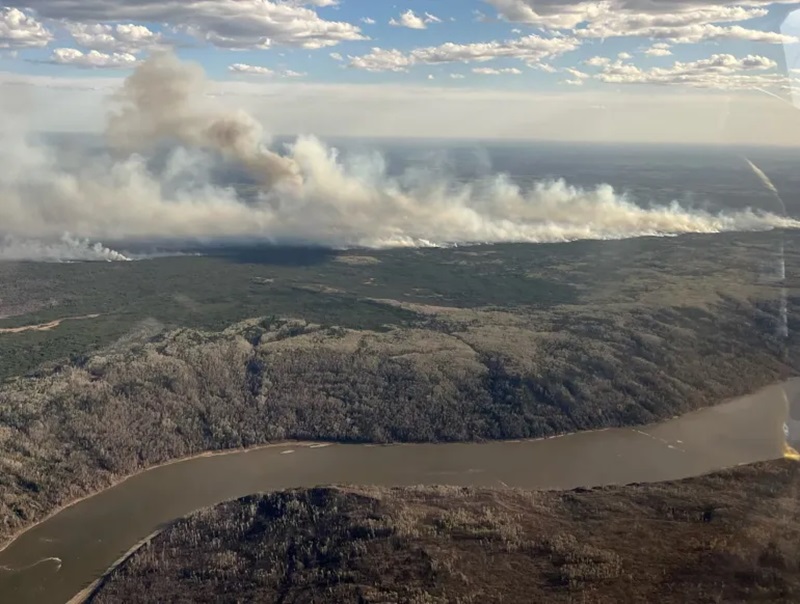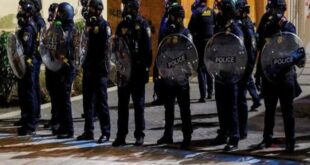
More than 130 wildfires are burning across Canada, federal tracker says, as massive blazes force thousands to evacuate.
Thousands of people have been evacuated as enormous, out-of-control wildfires scorch large swaths of territory in western Canada, with the country grappling with what could be another devastating fire season.
This week, residents of the small town of Fort Nelson, in northeastern British Columbia, were forced from their homes as a blaze grew “dramatically” in only a few days and was moving towards the community.
In the neighbouring province of Alberta, authorities gave people in parts of Fort McMurray – a town at the heart of the Canadian tar sands region – about two hours to leave due to an approaching wildfire.
Canada saw its most intense fire season on record last year, with hundreds of wildfires burning in provinces and territories across the country in a crisis experts said was worsened by climate change.
Here’s all you need to know about the current wildfires.
How many wildfires are burning in Canada?
More than 130 wildfires are currently burning across the country, according to a tally by the Canadian Interagency Forest Fire Centre (CIFFC).
Of those, 40 were considered out of control on Wednesday morning.
So far this year, Canada has experienced more than 1,000 wildfires that have burned approximately 336,000 hectares (830,000 acres) of land, the CIFFC found.
Where are the fires currently burning?
Most of the blazes are in British Columbia and Alberta, the CIFFC says on its website.
Others also have broken out in Saskatchewan, Manitoba and the Northwest Territories, among other parts of the country.
Where have evacuation orders been issued?
About 3,500 people were evacuated from Fort Nelson and Fort Nelson First Nation, in northeastern British Columbia, due to the Parker Lake wildfire. By Tuesday, the blaze had grown to more than 8,400 hectares (20,700 acres).
On Tuesday afternoon, authorities in Alberta also issued evacuation orders for the Abasand, Beacon Hill, Prairie Creek and Grayling Terrace areas of Fort McMurray.
The town itself, which was engulfed by a devastating wildfire in 2016, is currently under an “evacuation alert”, which means residents should be ready to leave if an evacuation order is issued.
The Alberta Wildfire agency said on Wednesday morning that favourable winds were expected to push the fire away from Fort McMurray while crews continue to work to contain the blaze.
Meanwhile, people have also been evacuated in parts of northern Manitoba, in central Canada. An out-of-control wildfire near the small towns of Flin Flon and The Pas – near the province’s border with Saskatchewan – has grown to 31,600 hectares (78,000 acres).
What is causing the wildfires?
Generally, wildfires in Canada are caused either by lightning strikes or human behaviour.
Some of the blazes currently burning in the country are what are known as “holdover fires”. The term refers to fires that continue to burn under snow during the winter and are reignited when the temperature warms in the spring.
Authorities have said drought conditions and high winds are propelling the wildfires.
Ben Boghean, a fire behaviour specialist with the BC Wildfire Service, said the northeastern region of British Columbia “has experienced multiple years of drought, with a below-normal snowpack this past winter”.
“As a result of this, our forest in the Fort Nelson zone are very receptive to new fire ignitions and rapid rates of spread,” he said, explaining that the Parker Lake wildfire ignited amid strong winds and grew eight kilometres (five miles) in four hours after it was first detected.
“This rapid growth highlighted how dry and volatile forest fuels are up here,” Boghean said.
Is the climate crisis playing a role?
Experts say higher temperatures have extended the Canadian wildfire season, which typically runs from late April until September or October, and increased lightning – a major cause of the blazes.
Mike Flannigan, research chair for predictive services, emergency management and fire science at Thompson Rivers University in British Columbia, told Al Jazeera last year that a warmer atmosphere also dries out fire fuels, such as the vegetation on forest floors.
These drier fuels then make it easier for fires to start and spread, and they lead to higher intensity fires that “are difficult to impossible to extinguish”, Flannigan said.
Ongoing drought and warmer temperatures in Canada have fueled wildfires in British Columbia. The #ParkerLakeWildfire has consumed more than 13,000 acres and triggered evacuations in #FortNelson. Check out images from Canada’s 2023 #WildfireSeason here: https://t.co/F79iU4jVY3 pic.twitter.com/kxpiiaW7CE
— USGS Landsat (@USGSLandsat) May 14, 2024
What other effects are the wildfires having?
Air-quality alerts have been issued in several Canadian provinces, as well as in the United States.
Over the past week, alerts were issued for parts of Montana, North and South Dakota, Iowa and Minnesota due to Canadian wildfire smoke, US media reported.
The record Canadian wildfire season in 2023 also set massive plumes of smoke south of the border to the US.
“The pressing question on many people’s minds: ‘Is this the new normal?’” three professors at the University of Iowa wrote in The Conversation this week. “From our perspective as air quality scientists, we think the answer is likely ‘yes’.”
SOURCE: AL JAZEERA – World Opinions




 World Opinions Débats De Société, Questions, Opinions et Tribunes.. La Voix Des Sans-Voix | Alternative Média
World Opinions Débats De Société, Questions, Opinions et Tribunes.. La Voix Des Sans-Voix | Alternative Média




